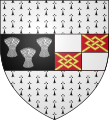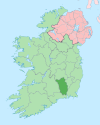Portal:County Kilkenny
The County Kilkenny Portal
County Kilkenny (Irish: Contae Chill Chainnigh) is a county in Ireland. It is in the province of Leinster and is part of the Southern Region. It is named after the city of Kilkenny. Kilkenny County Council is the local authority for the county. At the 2022 census the population of the county was 103,685. The county was based on the historic Gaelic kingdom of Ossory (Osraighe), which was coterminous with the Diocese of Ossory. (Full article...)
Selected articles

Kilkenny (Irish: Cill Chainnigh [ˌciːl̠ʲ ˈxan̠ʲəj], meaning 'church of Cainnech') is a city in County Kilkenny, Ireland. It is located in the South-East Region and in the province of Leinster. It is built on both banks of the River Nore. The 2022 census gave the population of Kilkenny as 27,184, the thirteenth-largest urban center in Ireland.
Kilkenny is a tourist destination, and its environs include historic buildings such as Kilkenny Castle, St Canice's Cathedral and round tower, Rothe House, Shee Alms House, Black Abbey, St. Mary's Cathedral, The Tholsel, St. Francis Abbey, Grace's Castle, and St. John's Priory. Kilkenny is also known for its craft and design workshops, the Watergate Theatre, public gardens and museums. Annual events include Kilkenny Arts Festival, the Cat Laughs comedy festival and music at the Kilkenny Roots Festival.
Kilkenny began with an early 6th-century ecclesiastical foundation within the Kingdom of Ossory. Following the 12th-century Norman invasion of Ireland, Kilkenny Castle and a series of walls were built to protect the burghers of what became a Norman merchant town. William Marshall, Lord of Leinster, gave Kilkenny a charter as a town in 1207. By the late 13th century, Kilkenny was under Hiberno-Norman control. The Statutes of Kilkenny, passed at Kilkenny in 1367, aimed to curb the decline of the Hiberno-Norman Lordship of Ireland. In 1609, King James I of England granted Kilkenny a Royal Charter, giving it the status of a city. Following the Irish Rebellion of 1641, the Irish Catholic Confederation, also known as the "Confederation of Kilkenny", was based in Kilkenny and lasted until the Cromwellian conquest of Ireland in 1649. From 1840 onwards, Kilkenny has not been administered as a city under local government law, but the Local Government Reform Act 2014 provides for "the continued use of the description city". (Full article...)
Selected history articles

The history of Kilkenny (from Irish Cill Chainnigh 'Cell or church of Cainnech/Canice') began with an early sixth-century ecclesiastical foundation, this relates to a church built in honour of St. Canice, now St. Canice's Cathedral and was a major monastic centre from at least the eighth century. The Annals of the Four Masters recorded the first reference Cill Chainnigh in 1085. Prehistoric activity has been recorded suggesting intermittent settlement activity in the area in the Mesolithic and Bronze Age. Information on the history of Kilkenny can be found from newspapers, photographs, letters, drawings, manuscripts and archaeology. Kilkenny is documented in manuscripts from the 13th century onwards and one of the most important of these is Liber Primus Kilkenniensis.
The Kings of Ossory had residence around Cill Chainnigh. The seat of diocese of Kingdom of Osraige was moved from Aghaboe to Cill Chainnigh. Following Norman invasion of Ireland, Richard Strongbow, as Lord of Lenister, established a castle near modern-day Kilkenny Castle. William Marshall began the development of the town of Kilkenny and a series of walls to protect the burghers. By the late thirteenth century Kilkenny was under Norman-Irish control. The original ecclesiastical centre at St. Canice's Cathedral became known as Irishtown and the Anglo-Norman borough inside the wall came to be known as Hightown. (Full article...)
Selected landmarks articles

Kilkenny Castle (Irish: Caisleán Chill Chainnigh pronounced [ˈkaʃlʲaːnˠˈçiːl̪ʲˈxan̪ʲiː]) is a castle in Kilkenny, Ireland, built in 1260 to control a fording-point of the River Nore and the junction of several routeways. It was a symbol of Norman occupation, and in its original 13th-century condition, it would have formed an important element of the town's defences with four large circular corner towers and a massive ditch, part of which can still be seen today on the Parade.
In 1967, Arthur Butler, 6th Marquess of Ormonde, sold the castle for £50 to the Castle Restoration Committee for the people of Kilkenny. The castle and grounds are now managed by the Office of Public Works, and the gardens and parkland are open to the public. The Parade Tower is a conference venue. Since 2002, ceremonies for conferring awards and degrees on the graduates of the Kilkenny Campus of the National University of Ireland, Maynooth, have been held at the castle. (Full article...)
Selected geography articles
Gowran (/ˈɡoʊrən/; Irish: Gabhrán) is a barony in the east of County Kilkenny, Ireland. The size of the barony is 430.5 square kilometres (166.2 sq mi). There are 35 civil parishes in Gowran. The chief town today is Gowran. The barony contains the ecclesiastical sites of Kilfane and Duiske Abbey The barony of Gowran is situated in the east of the county between the baronies of Fassadinin to the north (whose chief town is Castlecomer), the baronies of Kilkenny, Shillelogher and Knocktopher to the west (whose chief towns are Kilkenny, Bennettsbridge and Knocktopher), and the barony of Ida is to the south. It borders County Carlow to the east. The M9 motorway bisects the barony. (Full article...)
Gowran (/ˈɡoʊrən/; Irish: Gabhrán) is a town located on the eastern side of County Kilkenny, Ireland. The historic St. Mary's Collegiate Church is located in the centre of Gowran close to Gowran Castle. Gowran Park race course and Golf Course are located one km from the centre of Gowran. Gowran is located on the R448 regional road (former N9 national primary road) where it is crossed by the R702 regional road. The town is in a townland and civil parish and barony of the same name. (Full article...)
The River Suir (/ʃʊər/ SHOOR; Irish: an tSiúr [ənʲ ˈtʲuːɾˠ] or Abhainn na Siúire [ˌəun̠ʲ n̪ˠə ˈʃuːɾʲə]) is a river in Ireland that flows into the Atlantic Ocean through Waterford after a distance of 185 kilometres (115 mi). The catchment area of the Suir is 3,610 km2. Its long term average flow rate is 76.9 cubic metres per second (m3/s), about twice the flow of either the River Barrow (37.4 m3/s) or the River Nore (42.9 m3/s) before these join, but a little less than the Barrow's flow when it meets the Suir 20 km downstream (over 80 m3/s). (Full article...)
The Barrow Way (Irish: Slí na Bearú) is a long-distance trail in Ireland. It is 100 kilometres (62 miles) long and begins in Robertstown, County Kildare and ends in St Mullin's, County Carlow, following the course of the River Barrow and the Barrow Line of the Grand Canal through counties Kildare, Carlow, Kilkenny and Laois. It is typically completed in four days. It is designated as a National Waymarked Trail by the National Trails Office of the Irish Sports Council and is managed by Waterways Ireland. (Full article...)
Selected quotation
There once was two cats of Kilkenny
Each cat thought there was one cat too many So they fought and they fit And they scratched and they bit 'Til instead of two cats there weren't any. |
— |
Selected Did you know

- ...that Angela Downey won twelve All-Ireland medals?
- ...that James Graves (pictured) was born on St Canice's day, 11 October? (Full article...)
Selected slideshow image
Selected biography articles
Cainnech of Aghaboe (515/16–600), also known as Saint Canice in Ireland, Saint Kenneth in Scotland, Saint Kenny and in Latin Sanctus Canicus, was an Irish abbot, monastic founder, priest and missionary during the early medieval period. Cainnech is one of the Twelve Apostles of Ireland and preached Christianity across Ireland and to the Picts in Scotland. He wrote a commentary on the Gospels, which for centuries was known as the Glas-Choinnigh or Kenneth's Lock or the Chain of Cainnech.
Most of what is written about Cainnech's life is based on tradition, however he was considered a man of virtue, great eloquence and learning. His feast day is commemorated on 11 October in the Roman Catholic Church and the Eastern Orthodox Church according to their respective calendars (Gregorian or Church Julian) with additional feast days on 1st or 14 August in the Eastern Orthodox Church. (Full article...)
James Stephens (Irish: Séamus Mac Stiofáin; 26 January 1825 – 29 March 1901) was an Irish Republican, and the founding member of an originally unnamed revolutionary organisation in Dublin. This organisation, founded on 17 March 1858, was later to become known as the Irish Republican Brotherhood (I.R.B). (Full article...)
Marie Hanlon is a Dublin-based Irish artist working in a variety of media including painting, drawing, sculpture, video and installation. She has collaborated with Irish composers, most notably Rhona Clarke, in creating works which can be realised in both concert performance and gallery situations. (Full article...)
Victor O'Donovan Power (1860 – 30 December 1933) was an Irish playwright, novelist, and prolific short-story writer. (Full article...)
Selected sport articles
Liz Neary (born 1951 in Kilkenny, Ireland) is a retired Irish sportsperson. She played camogie at various times with her local clubs St. Paul's and Austin Stacks and was a member of the Kilkenny senior inter-county team from 1970 until 1987. Neary is regarded as one of the greatest players of all-time.
In a senior inter-county career that lasted for nineteen years she won seven All-Ireland medals, five National League medals and five Gael Linn Interprovincial medals. With her two clubs St. Paul's and Austin Stack's she collected a huge haul of twenty-one county titles and six All-Ireland club medals. (Full article...)
Related portals
Associated Wikimedia
The following Wikimedia Foundation sister projects provide more on this subject:
-
Commons
Free media repository -
Wikibooks
Free textbooks and manuals -
Wikidata
Free knowledge base -
Wikinews
Free-content news -
Wikiquote
Collection of quotations -
Wikisource
Free-content library -
Wikiversity
Free learning tools -
Wikivoyage
Free travel guide -
Wiktionary
Dictionary and thesaurus
































































